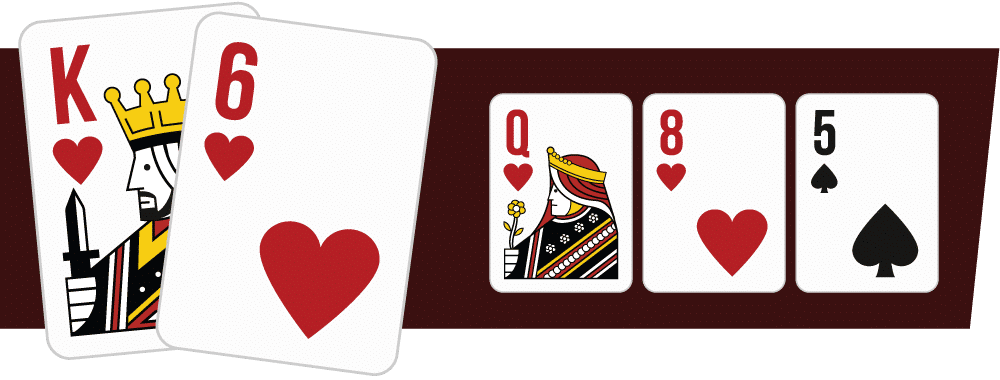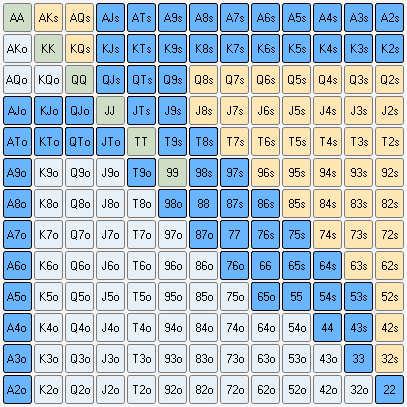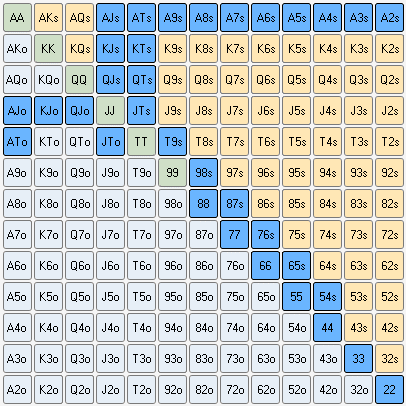Welcome to today’s Quick Plays video on completing from the SB. Many players complete with incorrect ranges from the small blind, which ends up creating really tough spots and ultimately extra loss. In this video we’ll discuss common mistakes, explain why they are mistakes, and then create a profitable range to complete with.
First, what is completing? This is when the SB just calls the big blind, rather than raising or folding. A completion can be done after there are 1, 3, or even 0 limpers…but this shouldn’t be confused with calling a preflop raise from the SB. That’s a totally different topic that we’ll tackle in a separate video. The mistake that many players make is simply completing with too many hands. For instance, take this example where there are 3 limpers to us in a live $1/$2 game. If you’d like, pause and write down the range you’d complete with here — just be honest!
In my coaching experience I notice that players tell me one range,but actually complete with many more hands. Especially in live games, when their boredom levels are high, their completion range gets quite wide. They may tell me that they only complete suited connectors, but in real-time they are also completing 87o and T9o. They may say they only complete suited Aces, but in real-time they also complete K6s. Do you do the same thing?
Mistake Hands
Why is it a mistake to complete with so many hands? To understand that, let’s look at the 3 major hand types that I feel people complete with incorrectly. They are:
- Suited Kings
- Suited Broadway Gappers
- Unsuited Connectors
When I say a suited King I don’t mean AKs or KJs. I mean something like K8s or K4s — the weak suited King that doesn’t perform particularly well. If we run a hand like K6s through Flopzilla we see the following:
- 18% top pair+
- 15% middle pair
- 11% flush draws
The issue is that if we complete with K6s here, we are going to see a 5 way flop OOP. Playing draws OOP is going to be very tough. Playing middle pair OOP is going to be very tough. And even top pair is going to be a bit tricky. Say the flop comes K75…what’s the plan? If you bet and get 1 caller, do you expect to win that pot often? If you bet and get 2 or more callers, do you expect to win that pot often? Even if you get just 1 caller and have the best hand most of the time, are you prepared to play 2 more streets OOP with top pair and no kicker?
We notice that when we think ahead, this situation becomes less ideal and that we are really just hoping to smash the flop or get involved in an easy drawing situation. But even when drawing, it’s tough to play draws OOP, tough to maximize value the times we DO hit the draw, and there could easily be RIO (reverse implied odds) against a higher flush since people love to limp in with suited AX hands. 
- 19% top pair+
- 15% weak-middle pair
- 11% flush draws
Now we’re going to have a similar issue with top pair as we did with K6. Our top pair hands are going to have kicker issues. And when we hit top pair with the low card in our hand, the texture is going to change considerably by the river. Drawing hands are also going to be tricky, and there will be more and more RIO as our top card gets lower and lower. The other thing to consider is HOW we smash boards. If we have a hand like Q8s and we smash on a Q85 board, there are lots of cards that come and change that texture.
If we have Q8s and smash on a board of JT9, the texture is super wet and it’s tough to maximize value being OOP. And when we have Q8s and the flop is 3 of our suit, we still have to dodge the 4th flush card AND hope that we get paid off on such an obvious board ALL while hoping we don’t run into an already higher flush. I say this and I know it sounds very pessimistic. And some people will say, “But with 3 limpers, how can’t we complete here getting such a sick price?” Sure, we are getting 9:1 on a call given the immediate pot odds. But the issue is that in NL and PL games it’s easy for the pot size to get out of control. So when you are in a RIO situation it can get very costly, very quickly. 
A Better Range To Use
When I look at the real range that many people complete with, it looks to be something like 33% of hands. However, I would suggest using something closer to 14%. My normal completion range against 1 or more limpers is going to include suited Ax hands, pairs that aren’t worth a raise, broadway hands that aren’t worth a raise, and suited connectors. Now, many of these hands can be tricky to play postflop, especially OOP, but with strong postflop skills they become easier (and of course much more profitable as well!).

33% Range Of Hands

14% Range Of Hands
Overall, many players would fare much better by deleting some of the hands they complete with from the SB. By doing this they strengthen their range, create better spots, and exit possible RIO situations early. It should also be noted that the 14% range I suggested hits TP+ and draws 10% more often than the 33% range, which is nothing to sneeze at. But regardless of the range you decide to complete with, just make sure you are working on your postflop skills and using logic to decide if that completion is really worthwhile. As always, if you have any questions please don’t hesitate to let me know. Otherwise, good luck out there, and happy grinding!

This is very helpful. It should cut my lossess at SB
That’s the goal 🙂
Nice vid split, but:
You let out our opponents completely. I think that we should still think about our opponent ranges. If there are 3 villains in there who limp in near 50 percent of the time or more and are passive postflop (what’s not unusual for live poker for example) I don’t see me folding even K7o as I will extract value with top pair often enough and I will know when I’m behind when the passive villains show aggression.
But your suggestions are perfectly fine in tighter live lineups and online games
I think players too often over-estimate their edge with hands like K7o, Q8o, 86o, and even J7s. The upside vs downside potential is rarely in your favor, and any postflop mistakes can turn a ‘close’ completion into a -EV one in a heartbeat.
Opinion on squeeze range? I squeeze with some of the lower AX suited (for A blocker value, say A4-6) and middle suited connectors (for playability, say 56-78) against a smaller limped field. My thinking is to remove those hands from the complete range and replace them with more suited 1 gappers.
That sounds like over-thinking it in most micro online/small live games. Balancing ranges is important when your opponents can think…not when they are solely focused on their own 2 cards and how quickly they can set money on fire =)
So are you saying you don’t squeeze at all? When do you?
Are we talking about actually squeezing, or raising limpers? If the latter, I most certainly do. But it’s usually with the strongest of stuff barring information. For instance, if you know the limpers hate big raises and thus would fold a ton, you can certainly raise large with a super wide range of hands. But barring info like that, keeping it strong side-weighted (TT+/AQ+ as a default) is usually the best idea.
This video reminds me of the old joke…how do porcupines make love? Carefully
if I’m getting 9to 1 11 to 1 I can play A7o Kxs ect…I just have to play them Carefully….
Hell in many games if I just checked my one pair hands down to the river unless the improve to w pair, and only bet 2 pair or better I would still make money…
Sure I get reverse implied odds oop all the time…and guess what reverse implied odds only matter if I’m ever putting in more then one bet.
Most of the 1-2 games I play in I can check top pair on the flop…let it check through and bet the turn…get a caller with 2nd pair..and check it through on the river…If its bet on the flop depending on position of the better the board my reads on the better bet size ect, I can fold..or call once…
And sure sometime I will check and somebody will bet in a way I know I can check raise with my over card and back door flush and make some money..so I do it. And every now and then I check my Ax to the river and win or bet my Ax when the the turn card pairs the bottom card on the board and bluff…
I say let the porcupines make love i’m sure they find it +ev…just be careful
If you have that kind of info and edge on your game, you can do lots of fun things (completing the SB included =) )
Hey James,
I’m just curious how you proceed by default, with a hand like AJ when it flops 1-pair into 3 opponents on various board textures? What’s your strategy for handling resistance?
Thanks,
Eric
I typically lead and go from there. Turn/river spots are very situational and can change based on how many players called my flop bet, run outs, etc.
What is your stance on raising with AJ from the blinds if you believe that it will effectively thin the field or scoop the pot pre-flop?
With that information I raise for sure.